Skip to comments.
Forecasting the Four Year Double Dip U.S. Recession
The Market Oracle ^
| Jan 24, 2009
| Paul_L_Kasriel
Posted on 01/30/2009 9:14:31 AM PST by Lazamataz
 DUBYA - No, our title does not refer to our 43rd president. Rather, it refers to the shape of an economic scenario that is beginning to look to us as the most probable going forward. The current economic environment is indeed bleak and there are precious few signs of a recovery. But we believe that if the massive fiscal stimulus package being worked up in Congress is financed largely by the banking system and the Federal Reserve, there is a good chance the economy will begin to grow by the fourth quarter of this year and continue to do so throughout 2010. And if we are correct on this, we also believe there is a good chance that the consumer price index will be advancing at a fast enough pace by the second half of 2010 to induce the Federal Reserve to become more aggressive in draining credit from the financial system.
DUBYA - No, our title does not refer to our 43rd president. Rather, it refers to the shape of an economic scenario that is beginning to look to us as the most probable going forward. The current economic environment is indeed bleak and there are precious few signs of a recovery. But we believe that if the massive fiscal stimulus package being worked up in Congress is financed largely by the banking system and the Federal Reserve, there is a good chance the economy will begin to grow by the fourth quarter of this year and continue to do so throughout 2010. And if we are correct on this, we also believe there is a good chance that the consumer price index will be advancing at a fast enough pace by the second half of 2010 to induce the Federal Reserve to become more aggressive in draining credit from the financial system.
This could set the stage for another recession commencing in 2012, or perhaps some time in 2011. So, the shape of the path of economic activity we see over the next few years is not a "V", a "U", or an "L", but a "W" - down, up, down, up, all within four or five years.
As we mentioned, the current economic environment is bleak. As shown in the attached Table 1, we are forecasting that real GDP will contract at an annual rate of nearly 5% in both last year's fourth quarter and this year's first quarter. Private domestic demand has collapsed - spending for personal consumption, residential investment and business equipment. With the U.S. recession having spread to the rest of the world, even demand for U.S. exports is now contracting. Businesses are desperate to reduce their inventories. With Detroit, for all intents and purposes, shut down for the month of January, business inventories will crater even more in the first quarter. With office, retail mall and hotel vacancies rising and with credit to finance commercial building all but dried up, the last domino to fall will be nonresidential construction expenditures. Chart 1 shows the history of annual average percent changes in real GDP and real personal consumption expenditures (PCE) from 1947 through 2007 along with our forecasts for 2008 and 2009. As you can see, we are forecasting for 2009 the largest percentage contractions in these two measures, minus 2.5% for real GDP and minus 2.0% for real PCE, during this time span. So, no sugar coating - this recession is likely to be the most severe in the post-WWII era.
Chart 1 - Real GDP and Real PCE percent change in annual average
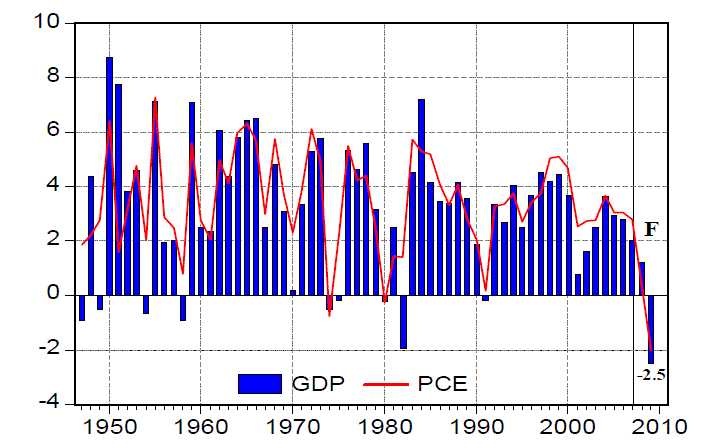
How will we know when we are going to pull out of this downward economic spiral? The same way we knew we were going into it. That is, keep an eye on the index of Leading Economic Indicators (LEI). Chart 2 shows that the LEI actually do tend to lead business cycle turning points. When the three-month moving average of the LEI quits declining, this will be a strong signal that a recovery is on the horizon. Right now, the LEI are not signaling that a recovery is imminent. But we will make a bet with you. The behavior of the LEI will signal a recovery before the consensus of economic forecasters does.
Chart 2 - Index of Leading Economic Indicators 3-month moving averageshaded
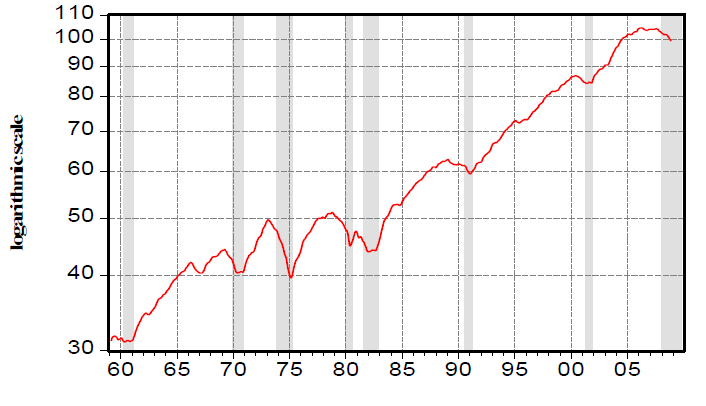
Although there are no signs that the economy has yet turned the corner toward recovery, there are some indications that the interbank credit market is beginning to thaw. Chart 3 shows that although the differential between the three-month Libor rate and the three-month Treasury bill rate remains abnormally wide, indicating heightened perceived interbank credit risk, this differential has narrowed considerably in recent weeks from its extremes. Chart 3 also shows that discount borrowing by depository institutions from the Federal Reserve has fallen significantly in recent weeks - from a record high of $112 billion in the week ended October 29 to a still-high $69 billion in the week ended January 14.
Chart 3
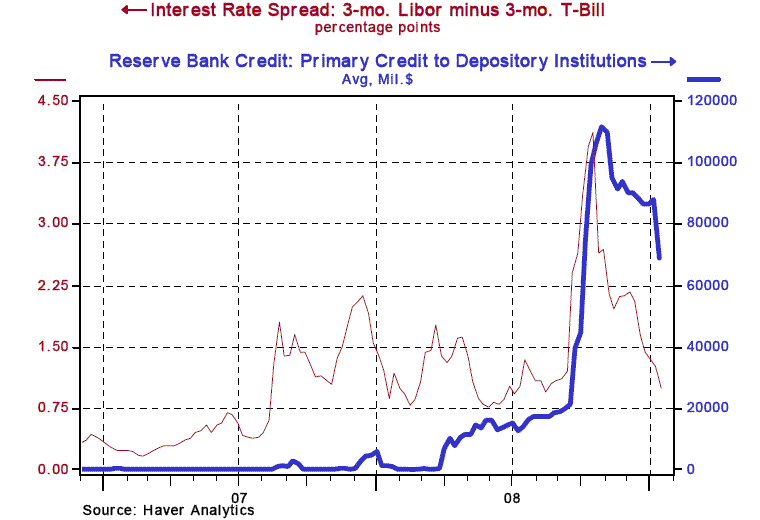
Despite the modest thawing in the interbank loan market, the bank-to-private sector lending market remains frozen. JP Morgan's acquisition of Washington Mutual, a savings and loan, in late 2008 caused commercial bank loans and leases to temporarily soar. But now that this one-time event is over and accounted for in the data, commercial bank lending is once again falling (see Chart 4). But news stories abound with speculation that the Obama administration is preparing to quickly purchase or guarantee hundreds of billions of dollars (trillions of dollars?) of toxic assets still on the books of banks in order to restart bank lending.
Chart 4
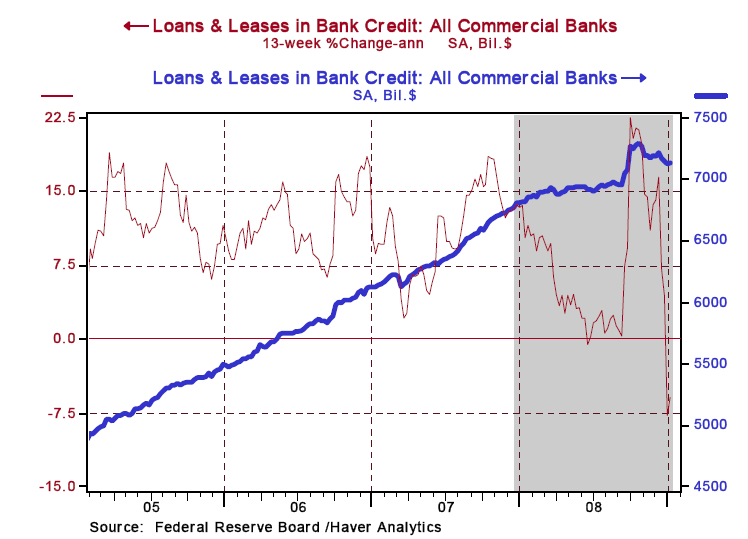
So, what is our rationale for a late-2009 economic recovery and a subsequent 2011 or 2012 slowdown/downturn? Massive federal spending funded by the Federal Reserve and the banking system. The Obama administration and Congress are in the process of developing a two-year fiscal stimulus package that at last, but likely not the final, count totals $825 billion. This fiscal stimulus program will include all things to all people - traditional and non-traditional infrastructure spending, aid to state and local governments, expansion of food stamp and unemployment insurance programs, and tax cuts for households and businesses. This massive federal spending and tax cut program will be financed by issuing additional federal debt. Who is likely to purchase this debt? The Federal Reserve and the banking system.
Chart 5 shows that in the third quarter of last year, credit creation by the Federal Reserve, the commercial banking system and the savings and loan system totaled $2.5 trillion at an annual pace. Total borrowing by the U.S. nonfinancial sector - federal and state/local governments, households and nonfinancial businesses - totaled $2.3 trillion. So, in essence, the Fed and the banking system monetized the entire increase in debt by the nonfinancial sector and then some. Chart 6 shows that it was the Federal Reserve doing the bulk of the "heavy lifting" with respect to this credit creation. The Fed created $2.4 trillion of the total $2.5 trillion credit created by the Fed, the banks and the S&Ls. If the stories are true about the Obama administration's plan to speed-up the government recapitalization of the banking system, then the Fed will be able to throttle back in its credit creation as the banks increase their share.
Chart 5
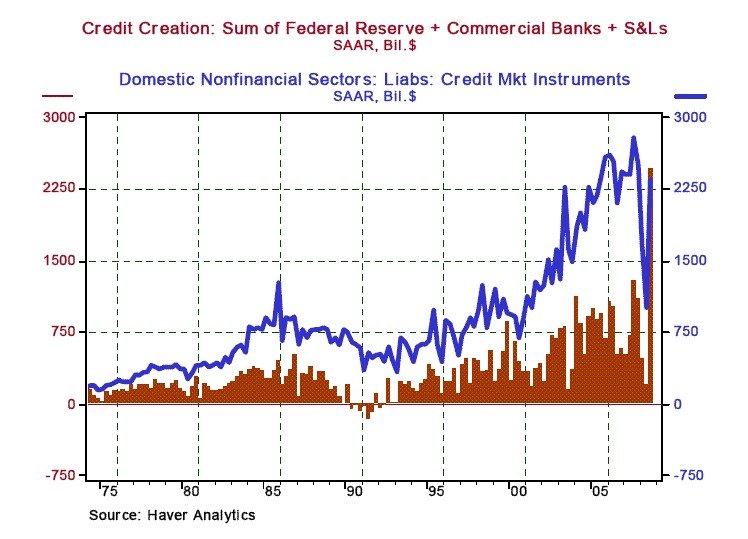
Chart 6
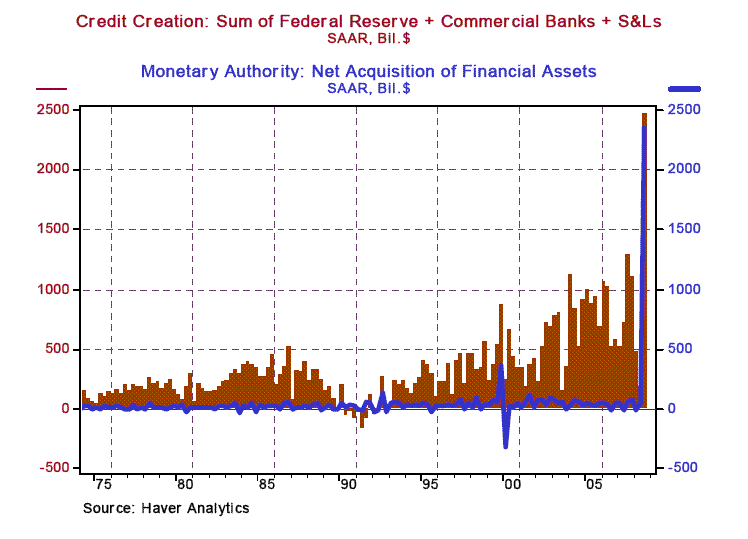
The implication of the banking system and the Federal Reserve monetizing large proportions of nonfinancial sector borrowing - government or private sector - is that the borrowers are able to increase their spending without any other entity cutting back on its spending. Thus, in terms of the GDP accounts, total spending in the economy increases. This is why we expect a recovery in real GDP by the fourth quarter of this year.
If monetizing nonfinancial debt were costless, economically speaking, the Zimbabwean economy would be the envy of the world. But, of course, there are economic costs. Monetizing debt means printing money. And printing money ultimately leads to accelerating prices - prices of goods, services and assets. As well intentioned as it may be, the government does not use economic resources as efficiently as the private sector. This inefficiency from government spending worsens the trade-off between aggregate demand and goods/services price increases.
And finally, with the Federal Reserve holding the price of credit below its free-market equilibrium, mal investment, as the Austrian economists say, occurs. That is, the lower-than-equilibrium interest rate structure encourages investment projects that cannot profitably be sustained when the interest rate structure ultimately must adjust upward. When the interest rate structure finally does adjust upward, unprofitable investment projects are abandoned and economic activity slumps.
If we are correct that a real GDP recovery commences by the fourth quarter of this year, then we believe the Federal Reserve will cautiously begin slowing its credit creation in the first half of 2010 - that is, the Fed will begin to slowly increase the federal funds rate. We then see inflationary pressures intensifying in the second half of 2010 and the Fed reacting to this with more aggressive hikes in the federal funds rate. This is what we believe will trigger the next official recession, or at least, growth recession.
In conclusion, over much of 2009, the year-over-year change in the CPI is likely to be negative. We advise investors not to extrapolate this "deflation" into 2010 and 2011. With the massive monetization of debt that is likely to occur, increases in the CPI are expected to resume. Keep in mind that from 1921 through 2008, the compound annualized growth in the CPI has been 2.9%. Also keep in mind that after declining by 5.2% in 1933, the CPI increased by 3.5% in 1934 despite significant apparent excess capacity in the economy as evidenced by the fact that annual average real GDP did not re-attain its 1929 level until 1936 and that the annual average unemployment rate did not fall below 20% until 1936. On last Friday, January 16, the yield on the constant maturity 10-year Treasury security closed at 2.36%. If we are correct about our economic scenario for 2010, then Treasury bond yields are destined to move higher later this year in anticipation of the economic recovery and increases in the CPI, and perhaps significantly higher in 2010.
*Paul Kasriel is the recipient of the Lawrence R. Klein Award for Blue Chip Forecasting Accuracy
THE NORTHERN TRUST COMPANY ECONOMIC RESEARCH DEPARTMENT
January 2009
SELECTED BUSINESS INDICATORS
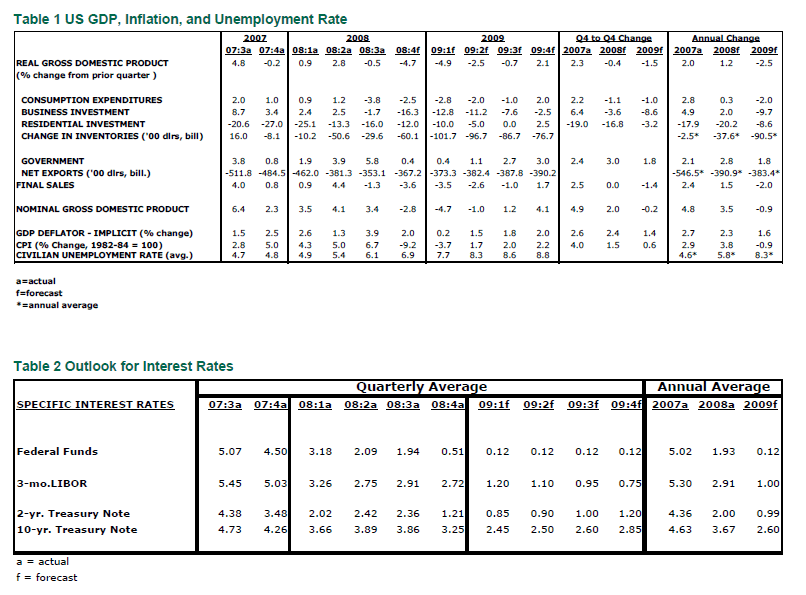
By Paul L. Kasriel and Asha Bangalore
The Northern Trust Company
Economic Research Department - Daily Global Commentary
Copyright © 2009 Paul Kasriel
Paul joined the economic research unit of The Northern Trust Company in 1986 as Vice President and Economist, being named Senior Vice President and Director of Economic Research in 2000. His economic and interest rate forecasts are used both internally and by clients. The accuracy of the Economic Research Department's forecasts has consistently been highly-ranked in the Blue Chip survey of about 50 forecasters over the years. To that point, Paul received the prestigious 2006 Lawrence R. Klein Award for having the most accurate economic forecast among the Blue Chip survey participants for the years 2002 through 2005.
TOPICS: Business/Economy; News/Current Events
KEYWORDS:
This is actually a pretty decent article. It's not the usual DOOOOOOM GLOOOOOM coming out of Market Oracle. It explains why there will be an upturn, and what will happen next -- by a guy who has a very good track record.
1
posted on
01/30/2009 9:14:31 AM PST
by
Lazamataz
To: Lazamataz
I wonder where he got his input data ... or did he just say, “four years of Obama means four years of recession”?
2
posted on
01/30/2009 9:17:02 AM PST
by
MathDoc
(Don't blame me, I voted for Governor Palin and the wrinkly white-haired guy)
To: Lazamataz
All of these predictions do no factor in the Socialist legislation the Democrats are installing as we speak. These figures are all based on pre-Obama data and economic policies.
With countless small business being sued by attorneys for wage discrepancies, Unions being forced on all Domestic business, big and small, all the taxes being imposed, Amnesty for all Illegals, etc,,, reality will be a spoiler of this dream scenario.
Then factor in rampant inflation and the actual effect that the Porkulus plan will really have on the economy. Any prediction of this type is completely worthless under the current disastrous economy.
3
posted on
01/30/2009 9:24:19 AM PST
by
PSYCHO-FREEP
(WHAT? Where did my tag line go? (ACORN))
To: Lazamataz
4
posted on
01/30/2009 9:24:25 AM PST
by
rellimpank
(--don't believe anything the MSM tells you about firearms or explosives--NRA Benefactor)
To: PSYCHO-FREEP
I hear ya man. There just ain't no point.

5
posted on
01/30/2009 9:27:38 AM PST
by
Lazamataz
(Illegal Zombies: Just Eating the Brains that Ordinary Americans Won't Eat)
To: Lazamataz
But we believe that if the massive fiscal stimulus package being worked up in Congress is financed largely by the banking system and the Federal Reserve, there is a good chance the economy will begin to grow by the fourth quarter of this year and continue to do so... Whew! Thank goodness that "the banking system and the Federal Reserve" have the Magic Piggybank Cornucopia! Our problems are solved!
Or maybe not.
The writing is on the wall, for those who can read.
"There is no means of avoiding the final collapse of a boom brought about by credit expansion. The alternative is only whether the crisis should come sooner as a result of a voluntary abandonment of further credit expansion, or later as a final and total catastrophe of the currency system involved."
-~~Ludwig Von Mises

6
posted on
01/30/2009 9:34:39 AM PST
by
Travis McGee
(www.EnemiesForeignAndDomestic.com)
To: Lazamataz
"...not the usual DOOOOOOM GLOOOOOM..."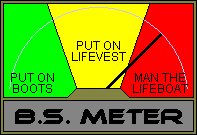 If that's true then I'd hate to see the real thing --this piece is pure bull with made up numbers. Come on people, get a grip!
If that's true then I'd hate to see the real thing --this piece is pure bull with made up numbers. Come on people, get a grip!
To: expat_panama
Well, this is happy for The Market Oracle.
They usually have us buried and dead for three weeks already.
8
posted on
01/30/2009 9:43:04 AM PST
by
Lazamataz
(Illegal Zombies: Just Eating the Brains that Ordinary Americans Won't Eat)
To: Travis McGee
Exactly.
I find NO comfort in the fact that the chefs that cooked up this crisis (banks, economists, the Fed, etc.) are the ones that are going to navigate the way out.
Flood the market with money, get credit markets open, grow, then, whoooaaa inflation, raise rates, raise rates, raise rates!
Sounds complicated.
Hyperinflation is the next crisis. Dollars will be worthless.
To: Lazamataz
I don't know, I think he's wrong about any 'upturn' happening.
Markets are acting petty peculiar these days, there aren't even any bounces anymore, just a steady decline. Obama's "stimulus package" was disappointing, and the markets reflected that.
And now Obama's "buy American" announcement, banning steel imports for any infrastructure work creats even more fear in the markets, fearful that this is only the beginning, Obama is going to pursue idiotic protectionism. Fear is not good, it creates a different kind of protectionism, investors protecting what ever is left of their investments before the bottom falls out of the bottom.
To: Nathan Zachary
I *LOVE* economic misery.
At least I'll get to feel SOMEthing.
11
posted on
01/30/2009 10:01:33 AM PST
by
Lazamataz
(Illegal Zombies: Just Eating the Brains that Ordinary Americans Won't Eat)
To: PSYCHO-FREEP
Any prediction of this type is completely worthless under the current disastrous economy. I completely agree. Its laughable. Even if you believe that magic unicorns crap skittles because you heard it on CNBS, it still doesn't make it true.
I'd LOVE to hear the authors "comments" re this: (M1 Multiplier going under 1)
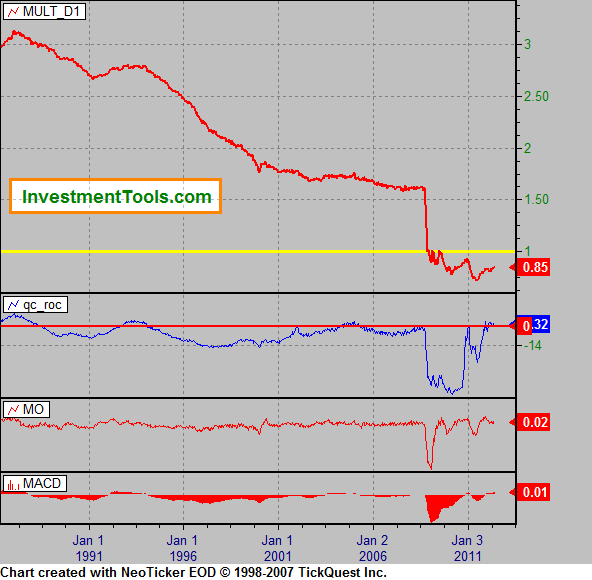
And see the update to this chart (its gotta be horribly outdated now):

To: Retired Greyhound
So really.
What's the point of living, then?
There is nothing but misery and pain and depression and horror and suffering and angst and worry and hatred and anxiety and poverty and hunger and sickness and sorrow and tears and melancholiness and death.
No matter what we do, it will get worse, and then it will get worse still, and nothing can save us.
Ever.
We will all die, alone, penniless, scourged and mocked and hated.
So what's the point?

13
posted on
01/30/2009 10:06:22 AM PST
by
Lazamataz
(Illegal Zombies: Just Eating the Brains that Ordinary Americans Won't Eat)
To: Retired Greyhound
"Hyperinflation is the next crisis. Dollars will be worthless." That's what I'm betting on. It's unavoidable now. And with Obama's "buy American" announcement, Watch our exports dry up and that GDP number double. Even if it is "only" steel, nobody wants to wait and see "what's next". Obama is an IDIOT for creating more fear in a market that is already full of fear and very jumpy.
Then again, that may be exactly what Obama the Marxist wants, to finish off the stock markets. Marxist like to control all things.
To: Lazamataz
"...this is happy for The Market Oracle. They usually have us buried and dead..."LOL --everything's relative!
To: Lazamataz
"I *LOVE* economic misery. At least I'll get to feel SOMEthing I feel what I had left in my portfolio getting lighter by the day, about $500 a day these last 3 days. Time to cut and run I think. Try make it back another time, after Obama is railroaded out and tarred and feathered.
To: Lazamataz
Dude, put the gun down. I can’t tell you what the purpose of your life is.
I live to serve Jesus Christ of Nazareth, and to love and care for the innocent.
My post about the excessive borrowing was not meant as doom and gloom. I was merely recapping why we are in this mess, and how government intervention caused it and is going to make it worse.
To: BureaucratusMaximus
You forgot one:
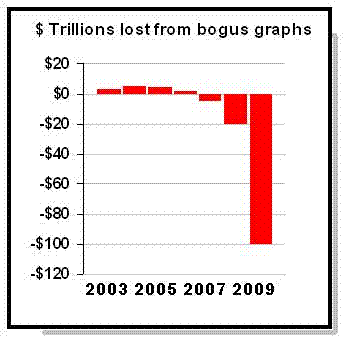
To: Lazamataz
Sounds good, and we haven’t even started to bail out Mexico yet!
To: Travis McGee
Your von Mises quote is right on the money. In one of the places he made such a statement, he also pointed out that to keep the credit induced boom going, it requires an actual acceleration of the credit expansion. We appear to be entering that phase, although, finally, the Republicans in Congress appear to be waking up.
It is going to get very ugly, I fear, however. The analyst who wrote the lead piece, assumes that the monetary authorities will be able to start pulling excess liquidity out of the market in a year or so. But that is extremely doubtful, beyond a mere token, which will only trigger a new leg down, and an even more compulsive attempt at pump priming.
20
posted on
01/30/2009 11:09:46 AM PST
by
Ohioan
Disclaimer:
Opinions posted on Free Republic are those of the individual
posters and do not necessarily represent the opinion of Free Republic or its
management. All materials posted herein are protected by copyright law and the
exemption for fair use of copyrighted works.
FreeRepublic.com is powered by software copyright 2000-2008 John Robinson
 DUBYA - No, our title does not refer to our 43rd president. Rather, it refers to the shape of an economic scenario that is beginning to look to us as the most probable going forward. The current economic environment is indeed bleak and there are precious few signs of a recovery. But we believe that if the massive fiscal stimulus package being worked up in Congress is financed largely by the banking system and the Federal Reserve, there is a good chance the economy will begin to grow by the fourth quarter of this year and continue to do so throughout 2010. And if we are correct on this, we also believe there is a good chance that the consumer price index will be advancing at a fast enough pace by the second half of 2010 to induce the Federal Reserve to become more aggressive in draining credit from the financial system.
DUBYA - No, our title does not refer to our 43rd president. Rather, it refers to the shape of an economic scenario that is beginning to look to us as the most probable going forward. The current economic environment is indeed bleak and there are precious few signs of a recovery. But we believe that if the massive fiscal stimulus package being worked up in Congress is financed largely by the banking system and the Federal Reserve, there is a good chance the economy will begin to grow by the fourth quarter of this year and continue to do so throughout 2010. And if we are correct on this, we also believe there is a good chance that the consumer price index will be advancing at a fast enough pace by the second half of 2010 to induce the Federal Reserve to become more aggressive in draining credit from the financial system. 








 If that's true then I'd hate to see the real thing --this piece is pure bull with made up numbers. Come on people, get a grip!
If that's true then I'd hate to see the real thing --this piece is pure bull with made up numbers. Come on people, get a grip!


